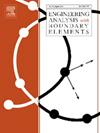Stokes方程的新通解和MFS方法
IF 4.1
2区 工程技术
Q1 ENGINEERING, MULTIDISCIPLINARY
Engineering Analysis with Boundary Elements
Pub Date : 2025-10-10
DOI:10.1016/j.enganabound.2025.106497
引用次数: 0
摘要
三维(3D) Stokes方程被重新表述为三阶偏微分方程,在定理1-4中推导出四个特定的解。在此基础上,提出了求解Stokes流问题的三阶基本解方法。用一种简单的方法证明了Papkovich-Neuber解,它只需要四个三维调和函数。采用一个三维调和函数和三个二维平面内调和函数的新方案更节省时间。证明了定理5-7中利用双调和势函数或双调和矢量求Stokes方程新解的三个重要方法;经过冗长的论证,它们是完整的。在定理8中给出了一个完整的通解,并通过一种简单的方法重新推导了slobodyanski通解;它们都是用笛卡尔坐标系中的三谐函数来表示的。并将点力作用下的新解作为应用,生成了Stokeslet。提出了自动满足不可压缩条件的五种新的数值方法。将简化的MFS与Papkovich-Neuber解合并为非对称Stokeslet方法。还推导了两个偶极子源MFS。为了探讨所提出的数值方法的效率和准确性,对包括基准问题在内的一些算例进行了测试。本文章由计算机程序翻译,如有差异,请以英文原文为准。
New general solutions and MFS methodology of Stokes equations
Three-dimensional (3D) Stokes equations are reformulated to be the third-order partial differential equations, with four specific solutions being derived in Theorems 1–4. Then a third-order method of fundamental solutions (MFS) to solve the Stokes flow problems is developed. The Papkovich–Neuber solution is proven with an easier manner, which needs four 3D harmonic functions. The new solution with one 3D harmonic function and three 2D in-plane harmonic functions is more saving. Three important methods in Theorems 5–7 are proven to seek new solutions of the Stokes equations by means of a biharmonic potential function or a biharmonic vector; they are complete through a lengthy proof. An effort is made in Theorem 8 for providing a complete general solution, and the Slobodyanskii general solution is re-derived via a simple way; both of them are presented in terms of three harmonic functions in the Cartesian coordinates. The new solutions under a point force are employed to generate the Stokeslet as an application. Five fresh numerical methods are developed which automatically satisfy the incompressibility condition. A reduced MFS together with the Papkovich–Neuber solution are merged into an unsymmetric Stokeslet method. Two MFS with dipole source are also derived. To explore the efficiency and accuracy of the proposed numerical methods, some examples including a benchmark problem are tested.
求助全文
通过发布文献求助,成功后即可免费获取论文全文。
去求助
来源期刊

Engineering Analysis with Boundary Elements
工程技术-工程:综合
CiteScore
5.50
自引率
18.20%
发文量
368
审稿时长
56 days
期刊介绍:
This journal is specifically dedicated to the dissemination of the latest developments of new engineering analysis techniques using boundary elements and other mesh reduction methods.
Boundary element (BEM) and mesh reduction methods (MRM) are very active areas of research with the techniques being applied to solve increasingly complex problems. The journal stresses the importance of these applications as well as their computational aspects, reliability and robustness.
The main criteria for publication will be the originality of the work being reported, its potential usefulness and applications of the methods to new fields.
In addition to regular issues, the journal publishes a series of special issues dealing with specific areas of current research.
The journal has, for many years, provided a channel of communication between academics and industrial researchers working in mesh reduction methods
Fields Covered:
• Boundary Element Methods (BEM)
• Mesh Reduction Methods (MRM)
• Meshless Methods
• Integral Equations
• Applications of BEM/MRM in Engineering
• Numerical Methods related to BEM/MRM
• Computational Techniques
• Combination of Different Methods
• Advanced Formulations.
 求助内容:
求助内容: 应助结果提醒方式:
应助结果提醒方式:


